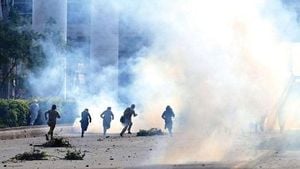The Benemérita Universidad Autónoma de Puebla (BUAP) has announced the suspension of on-site classes and the transition to virtual learning following student protests and security concerns at the university. The decision affects several academic units, including the Faculty of Medicine, where tensions have escalated over leadership changes and unresolved grievances.
Beginning on February 26, 2025, students from various programs such as Medicine, Fisioterapia, Nutrición Clínica, Ciencia Forense, and others actively protested against the current administration, particularly focusing on the installation of new leadership. The protests manifested through demonstrators closing access points to Ciudad Universitaria, effectively barring entry to faculty members and disrupting academic activities.
According to the BUAP, the transition to virtual classes aims to prioritize the safety and well-being of the university community. The announcement states, "La BUAP reafirmó que la universidad se mantiene en disposición de cumplir los acuerdos alcanzados," emphasizing the university's commitment to fulfilling agreements established with students when they engaged in initial negotiations.
The administrative decision to shift to online classes will take effect across various academic levels starting February 27, with the Faculty of Medicine transitioning to virtual formats by March 3. Meanwhile, academic activities within the regional complexes will continue as scheduled but with heightened security measures.
Claudia Teresa Cedillo Rojas, acting director of the Faculty of Medicine, highlighted the university’s efforts to engage with students through official meetings. "Este conflicto evidencia la división entre los alumnos sobre las negociaciones con la institución," she remarked, reflecting the challenges faced by the administration as they navigate student divisions during this tumultuous period.
Though initial meetings were scheduled to address the students' concerns, they were thwarted by factions of students who opposed the negotiations without being part of the signed agreements. The first working table, meant to discuss clinical placements and service internships, failed to convene due to these interruptions. This disruption signals not only disunity among the students but also raises questions about the future of dialogue and resolution within the faculty.
Every day, as the protests continued, students expressed their dissatisfaction with the newly appointed leadership, particularly targeting Cedillo Rojas. Many participating students felt the new administration was not addressing their pressing needs adequately, which led to their determined stand outside the university's main offices.
To minimize educational disruption, BUAP’s administration moved quickly to implement safety protocols, announcing the decision to hold classes virtually as early as possible. They stressed the importance of continuing educational activities, even when faced with protests and closures.
The BUAP's adaptation to online classes marks another chapter in the efforts to maintain educational continuity, echoing changes many other institutions have had to undertake during various crises. The administration has repeatedly urged students to engage with the process and work collaboratively toward solutions.
The student protests at BUAP reveal deep-rooted issues within the administrative structure of its Faculty of Medicine and reflect broader challenges faced throughout educational institutions nationwide. With many students rallying together, it remains to be seen how both the protests will affect future administrative decisions and whether the university can effectively navigate this period of unrest.
While the transition to virtual classes is expected to provide temporary relief for safety concerns, it is clear this situation requires sustained dialogue and collaboration between students and the administration. The administration's commitment to addressing grievances is evident, and timely engagements may be pivotal for restoring peace and order within the university.



